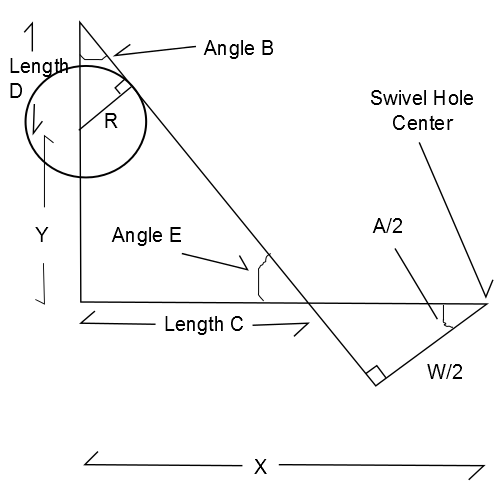Cold Saw/V1 Design Rationale/Hold System/Base/Elevated Mounting Calculation
Calculations: Dimensions of the Mounting Rectangle between the Base Plate and the Base Flat Bar
We want the dimensions to enable the Cold Saw to swivel at least 90 degrees.
Assume that what rotates on the swivel hole will be a swivel plate, and that the swivel plate will be long towards the back of the Cold Saw.
Assume that the swivel plate's hole is centered along its width.
We are concerned about the width of that swivel plate because it is the swivel plate's width that determines the angle at which the swivel plate contacts the spacers (the ones that isolate the base plate from the base flat bar).
Assume that the spacer is round.
Let the length and width from the swivel hole to the spacer hole of the mounting rectangle be X and Y, respectively.
Let the width of the swivel plate be W.
Let the radius of the spacer be R.
Let the swivel angle be A.
Let Angle B, Length C, Length D, Angle E be placeholder variables that we use only for the calculation but do not include in the final equation.
We are solving for A.
From trigonometry, we know that cosine of an angle in a right triangle equals horizontal length divided by hypotenuse length.
- 1 So we know that the cos(A/2) = (W/2) / (X - Length C)
But we don't want Length C in our solution so let's put it in terms of the desired variables.
From trigonometry, we know that the length divided by the sine of its associated angle equals another length divided by the sine of its associated angle.
- 2 So we know that (Length C/sine[Angle B]) = ([Y + Length D]/sine[Angle E]).
We see that in the process of solving for Length C, we've introduced 3 more placeholder variables, Length D, Angle B and Angle E.
Let's quickly solve for these new variables in terms of what we want.
From trigonometry, we know that the sum of a triangle's inner angles is 180 degrees, equivalent to about 3.14 radians.
So we know after a bit of angle calculations that Angle B = (A/2) and Angle E = 90deg - (A/2).
From trigonometry, we know that the hypotenuse length of a right triangle is equal to the vertical length divided by the sine of its associated angle.
So we know that Length D = R / sine[Angle B].
Filling in 3 placeholder values in 2, we get (Length C/sine[A/2]) = ([Y + [R/sine[A/2]] / sine[90deg - A/2])
- 3 Simplifying, we get Length C = (Y(sin[A/2]) + R) / (cos[A/2]).
Replacing Length C in 1 with 3, we get cos[A/2] = (W/2) / ( X - (Y(sin[A/2]) + R) / (cos[A/2]) )
Simplifying, we get Xcos(A/2) - Ysin(A/2) - R - W/2 = 0
